Less than three months after our art vending machine was filled with another 1,400 commissioned art objects, it has sold out. Visitors to the museum might have pulled a picture by Ruthe Zuntz from the machine. Pieces from her “PHOTOMAT: Challenging WallMAT” series, as the photographer entitled her square Dibond aluminum prints which cover ten different motifs, could be sparkling in many new households – like Ruthe herself whom I recently met.
Ruthe, you’re actually known for large, space-filling installations. And yet, for the art vending machine you produced a series of small photo prints. How did that happen?
I found the project really exciting because it matches one of my basic philosophies: art can do so much to move and help change things. Because of the art vending machine, people now have the chance to take a fragment of my work home with them – a piece of “takeout” art.
The pictures in your series for the art vending machine, “PHOTOMAT: Challenging WallMAT”, originated from your 2007 project, “Challenging Walls”, where you projected photographs from Israel, Palestine, Northern Ireland, Cyprus, and Germany onto a piece of the wall that separates Israel from the West Bank. Could you tell our readers something about that project? We have some experience with walls here in Germany…
I was here in Berlin for the first time shortly before the Wall fell, prior to moving here permanently in 1991. At that time I thought the era of walls was finally over – I was so glad! And then in 2003 the wall in Israel was built. One can see it as protection, but one can also read it differently: it separates people from one another, friends and enemies both. Together with other artists, I played with the wall, using it as a ‘silver screen’. This is another connection to the pictures I created for the art vending machine! They’re printed on silver plates – like the silver screen. (Laughs.)
What did you want to achieve with “Challenging Walls”?
The idea for the project occurred to me first in 2003, at a time when there were a number of terror attacks in my home country, Israel. I was already living in Berlin, but friends from Israel called me often, sounding more and more desperate. I couldn’t just stand by and watch anymore. I wondered what I, as one little artist, could do to create a spark of hope and peace. Gradually I developed “Challenging Walls”: it was about showing what everyday life looks like for people who are separated by walls. Artists from Israel and Palestine shot photos of completely everyday scenes on each side of the wall, and in this way opened up a window. To give a more universal perspective, artists from Europe (Northern Ireland, Cyprus, and Germany) were also invited to contribute their views on walls and how we live life with them.
The result was an enormous multimedia production on a segment on the wall…
…when I saw it for the first time, after all the long hard work involved, I was very moved. Many people told me beforehand that the project would fail, that I wouldn’t get the necessary permits let alone find a Palestinian photographer. But everything worked! The Palestinian photographer has even become a good friend of mine – he lives across the street from me now. So we really did break down walls. (Laughs.)
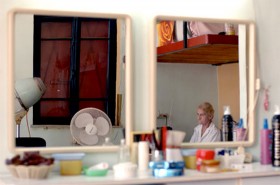
Israel 2007: Ruthe was moved by the woman at the hair salon. Photo used with friendly permission of the artist.
In the ten photos from Israel that you chose for the art vending machine, the diversity of your motifs is striking: there are pictures that come across as very melancholy, almost mournful, and then there are some that show their own kind of sparkling wit…
These are the various sides of the country. When you talk about melancholy, you must mean the picture with the old woman sitting in the hair salon…This woman really touched me – she looks like she’s been waiting for years for something to happen, but it hasn’t.
What’s the significance of the picture of the laundry blowing in the wind?
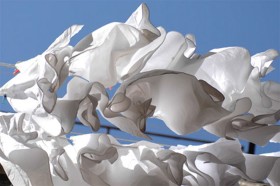
Israel 2007: Laundry is a recurring motif for Zuntz. Photo used with friendly permission of the artist.
Laundry is an interesting subject for me. The first summer I spent in Berlin, I was fascinated by people’s behavior here: there were people lying in the sun in a park in the middle of the big city – naked. Israelis and Palestinians would never do that. Instead though, we hang our most intimate laundry outside to dry.
What was it like for you, aside from the nudity, to move to Berlin?
Coming here, I basically brought my father’s life full circle. On my paternal side I’m 16th generation German. My grandfather sent my father to Palestine in 1939, but he himself wanted to stay in Germany. When my father visited me in Berlin, he spoke German for the first time in decades. My being here allowed him to make his peace with Germany. All the better that these Israeli and Palestinian fragments could come to Berlin with “PHOTOMAT: Challenging WallMAT”. That’s exactly the idea of a “united world”…
…meanwhile, the art vending machine is already sold out…
Really? That’s great! That means these pieces are already at home with people, spreading their aura.
Ruthe Zuntz was interviewed by Alice Lanzke, Media.
More by and about Ruthe Zunzt can be found at her website. She is currently working on a new exhibition in Berlin-Friedrichshain and, as her next project, plans to shoot a science fiction film about peace between Israelis and Palestinians – keeping it exciting!
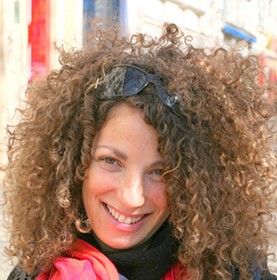
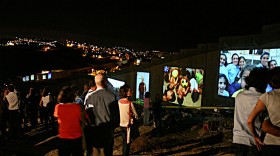
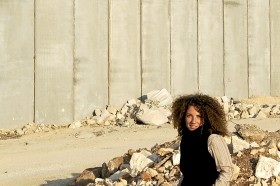
Ruthe Zunzt,
Do you know if you are related to the coffee makers of Bonn? My grandmother was kathe Zunzt of Frankfurt am Main. We may share a story perhaps.
With kind regards
Kate Sacof